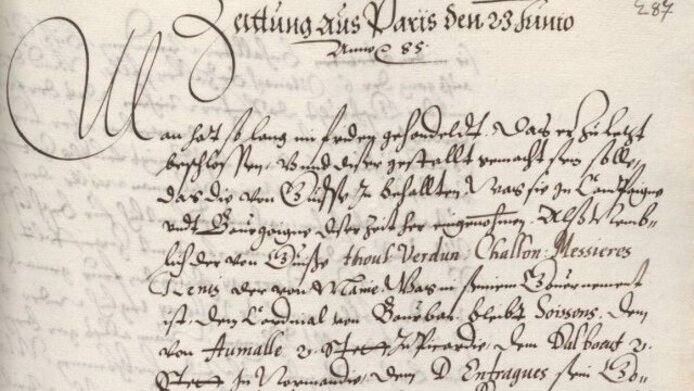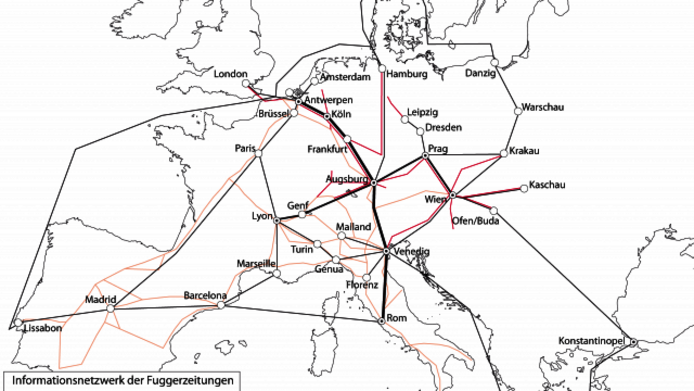The birth of newspapers

In the late 16th century, two brothers from the illustrious Fugger merchant family had news from all over the world sent to them by mail to Augsburg. At the time, so-called novellantes compiled and wrote down news which they forwarded to wealthy subscribers such as the Fuggers, thus establishing the first commercial news medium in Europe. The Fugger brothers had these newsletters bound and compiled in annual volumes. Being part of the Imperial Library holdings in Vienna as of the 17th century and housed at the Austrian National Library today, their collection comprises about 16,000 newsletters in German and Italian.
“The collection covers the period between 1568 and 1605, precisely the time leading up to the first printed newspapers,” notes Katrin Keller. Previously, the emergence of periodical newspapers in Europe had been ascribed to the year 1605 which saw the first printed weekly being published in Strasbourg. According to the historian at the Austrian Institute of Historical Research at the University of Vienna, however, that date is now open to discussion, since the Fugger collection, as well as other collections, showed that modern news systems had developed prior to that.
Europe-wide information network
Together with Nikolaus Schobesberger and Paola Molino, principal investigator Katrin Keller processed the complete collection of handwritten newspapers in Vienna in a project supported by the FWF. Although there are other archives, for instance in Marburg, Dresden or Munich, which have comprehensive handwritten news holdings, the Fuggerzeitungen (Fugger newsletters) in Vienna is the most well-known of these collections. Within the project, the material was also digitised and has now been made accessible to international research in a database.
Personal details
Katrin Keller is Director of the Institute for Habsburg and Balkan Studies and Director of the research unit History of the Habsburg Monarchy. Her main research interests are women in courtly society, nobility and the court, urban history and the history of Saxony. Keller is the author and editor of numerous books.
More information
Thanks to Katrin Keller and her team, the content is easily accessible: the scholars have indexed about 10,000 individuals and 5,500 locations mentioned in the newsletters. The indexes also facilitate reconstruction of the sizeable Europe-wide network of news transfers that existed in the late 16th century, as is also demonstrated by the map material in the database. This clearly shows that Rome, Venice, Augsburg, Cologne, Antwerp, Vienna and Prague were the big “news centres” of the period, although some of the news also came from overseas, from India, North Africa and the Middle East.
The birth of the modern press
While always considered significant, the Fugger collection was usually believed to constitute something of an exception or an isolated body of material. Comparisons facilitated by digitisation now show a different picture, corroborating recent research that found the Fugger newsletters to be an integral element of the overall media landscape in Early Modern Times. In her research project, Katrin Keller makes an important contribution to these insights by comparing other newsletter collections with the Fuggerzeitungen. – She comes to the conclusion that “there were identical newsletters in other places, including Dresden, Wolfenbüttel or Leipzig and Weimar“. This research project has made our understanding of media history more complete, establishing that the Fuggerzeitungen were actually part of an important information network in Europe. The newsletters also marked the beginning of regular news reading in the German-speaking area. “The demand for news was actually catered to before 1605, when printed newspapers began”, Keller emphasises. Developments were accelerated also by the influence of Italy, where newswriting and communication was commonplace earlier than in the German-speaking area.
Political reports
The newsletters were mainly an instrument of political communication. The Fugger brothers, just as the Elector of Saxony or the Duke of Bavaria, read the news to obtain as comprehensive an insight as possible into what was happening at their time: “Whereas two thirds of the reports provided information about military developments, important treaty negotiations, princely weddings or political events, the Fuggerzeitungen also contain stories about explorers’ journeys to overseas territories. These stories were often longer texts, sent as supplements to the actual newsletter. ‘The conquest of Santo Domingo by the English seafarer and circumnavigator Sir Francis Drake’ was one such supplement”, Katrin Keller elaborates. For historians, the Fuggerzeitungen thus represent a valuable resource for political and other topics. From the point of view of media history, the insights provided by the project supply a new picture of the beginnings of a modern news system.







